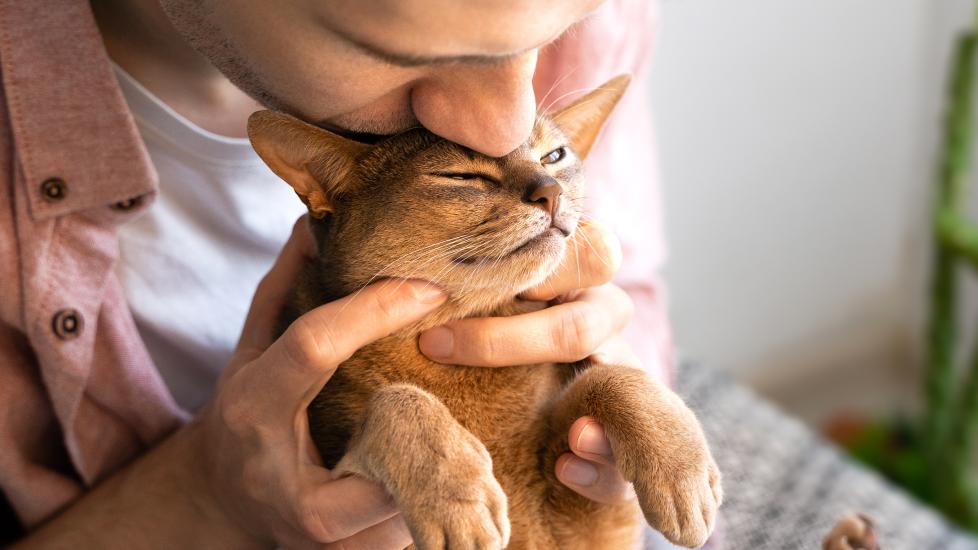9 Surprising Ways To Say “I Love You” in Cat Language
Daria Bulgakova/iStock / Getty Images Plus via Getty Images
You may never perfect your meow, but perhaps you don’t need to if you want to say “I love you” to your cat.
“Communicating using ‘cat language’ means that you’re purposely communicating with your cat in a way they will understand,” says Joey Lusvardi, a certified cat behavior consultant and owner of Class Act Cats.
Here are nine ways to show your cat you love them.
1. Exchange Slow Blinks
Did you know that cats communicate trust and relaxation via a simple gaze? Some call it the slow blink, others call it “kitty kisses.” No matter its moniker, you’ll find that it’s a simple gesture to do: Gaze at your cat, slowly closing your eyes halfway and then gradually opening them again. You’ve just said “I love you” in cat!
2. Create a Routine
Building trust means being the dependable pet parent your cat knows they can rely on. Lusvardi suggests establishing a predictable routine, like consistent mealtimes, engaging playtime sessions followed by tasty treats, and even relaxing moments for cuddles or grooming.
“Cats thrive when their world is predictable,” he says. “By keeping things as consistent as you can for your cat, they’ll have a pretty good idea of what’s coming next, which provides a sense of safety.”
3. Be a Consistent Communicator
Mixed signals aren’t beneficial to any relationship, including the one with your cat. “They’ll just end up confused and you’ll end up frustrated,” says Lusvardi. Once you set a house rule, it's important to get everyone on the same page.
As an example, Lusvardi gives using your hands as a toy to play with your cat: “If most people avoid using their hands to play but one member of your household still plays with the cat using their hands, the cat is getting mixed signals.”
4. Play with Your Cat
Your biscuit-making feline is a fierce predator! Or at least it will boost their confidence and give them a surge of endorphins to play like one. The best games to play with your cat are hunt and catch.
Take short breaks when petting your cat. This gives them the option to end the interaction or invite more pets.
A good way to do that? Interactive play with wand toys that flutter, skitter, or crawl like a real bird or bug. When your cat’s worn out and has sufficiently “caught” their prey, you can reward them with a treat!
5. Provide Nutritious Meals
Speaking of celebrating your cat’s wild side, feed your obligate carnivore a well-balanced and nutritious diet rich in animal proteins.
For an added element of hunting fun during meals, consider incorporating food puzzles or lick mats. To learn more about your cat’s ideal diet or how much and how often to feed them, consult your veterinarian. They can help you select high-quality food that suits your cat’s individual needs.
6. Spend Quality Time Grooming
“Cats who are friendly toward each other will often engage in mutual grooming,” Lusvardi explains, and “brushing your cat is similar to this behavior.” It’s a good way to spend quality time with your cat and help keep matted fur and hairballs at bay. Your cat might even return the favor by grooming (licking) you.
While grooming is the love language of some cats, others aren’t as keen. Forcing it can create stress and negative associations. When that’s the case, focus on activities you know your cat enjoys and leave the brushing exclusively for routine wellness grooming.
7. Respect Their Petting Preferences
Cats are really good at nonverbal communication; we just have to know what signs to look for. Slow blinks, purring, headbutts, and relaxed posture, for example, indicate that they’re open to affection. A thumping tail, flattened ears, dilated pupils, and backing away, on the other hand, are clear “stop” signals. Respecting your cat’s boundaries builds trust and helps them feel safe at home.
Cats are intuitive, picking up on moods, energy, and interpreting our intentions through gestures and tone of voice
So, what’s the best way to lovingly pet your cat? First, offer your hand and wait patiently for them to approach you. They might even head bump your hand. Begin with gentle strokes around the head, chin, and cheeks. These are areas with scent glands and they tend to be the most loved areas to be scritched, scratched, and petted.
Avoid the belly, legs, and tail, unless your cat actively invites pets to these extra-sensitive areas. Lastly, take short breaks when petting your cat. This gives them the option to end the interaction or invite more pets.
8. Reward Your Cat
Want your kitty to associate your presence with fun activities and tantalizing treats? Of course you do!
By rewarding desired behaviors using a clicker trainer, treats, and praise, you’re not just teaching manners or even fun tricks; you’re learning how to communicate to your cat in a positive way.
Even if your mischievous furball turns your houseplant into a jungle gym, you’ll have the skills to redirect their behavior without resorting to fear-based tactics, which can damage your relationship. Keep in mind, however, that experts recommend limiting treats to 10% of your cat’s daily caloric needs.
9. Use Positive Communication
Cats are intuitive, picking up on moods, energy, and interpreting our intentions through gestures and tone of voice. One study even showed that cats are more likely to respond to higher-pitched, sing-song tones—aka baby talk. On the other hand, forceful handling, loud gestures, and harsh tones can all come across as threatening.
Expressing the love you feel for your cat is easy when you know how. It involves both learning and using the nuances of cat language to communicate in ways your cat understands, as well as providing the care, quality time, and positive interaction your kitty needs.
